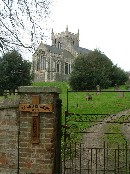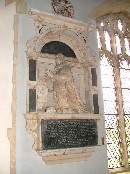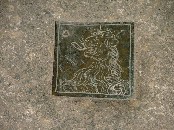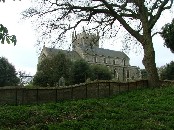| |
|
St
Withburga, Holkham
 |
|
This
massive church would be quite at home in the
centre of a large town, but here it sits on a
hilltop in a remote corner of the Holkham Hall
estate, with only deer and sheep for company. It
looks all of its restoration of the late 1860s,
but there is medieval work at the core. Not that
this matters much, because James Colling's
rebuilding was wholly excellent, creating a big,
light, rural estate church that was nevertheless
grand enough to suit Holkham Hall and the Cokes,
the Earls of Leicester, who own it. The Hall is
about a mile away, and you can see it shimmering
across the park and lake from the south entrance
of the church. In between, flotillas of sheep and
deer graze their way gently across the green and
into the great oaks of the woods. It is all
absolutely charming, and not the less so for
being an almost entirely man-made landscape.
|
That said,
the mound on which St Withburga sits is an ancient place.
It has been suggested that it is an Iron Age site,
perhaps for burials or a temple. It is composed entirely
of sand, and it is most likely that it is a dune thrown
up by the sea, which is now more than a mile from the
church to the north.
| The
graveyard wall surrounds the mound completely,
and it is very pleasing to navigate the church in
what is effectively a moat, noting the mausoleum
to the west, and looking up at the great west
front which looks like something you might come
across on the Loire. The great
tower must make a fine view from the house.
Although it incorporates earlier work, it is
entirely rebuilt. You enter through the south
porch beneath it, a bold, confident space which
is of itself bigger than some Norfolk churches I
have been in. The south doorway is evidence of
the earlier church, I think, although the marble
tiling of the floor has lifted it up considerably
and left the arch looking most curious. And then
you step through into a wide, high, cool, open
space.
|
 |
|
Again,
there is a feeling of being in France, as if this was
some great Abbey church. The rebuilding was paid for by
Juliana, Countess of Leicester, and she died in 1870,
just as it was completed. Her simple effigy lies in the
bare north aisle chapel, and perhaps the biggest surprise
about St Withburga is how simple and understated
everything is. There are generations of vast Coke
memorials, of course - but they are not here. They are in
Tittleshall church, some fifteen miles to the south,
another outpost of the Coke empire. Here, the memorials
are simpler, and all the more affecting: a sequence of
17th century memorials, brasses and ledger stones
collected together in the south aisle chapel, and the
moving wall memorials in the north aisle to Coke sons
killed in the World Wars.
   

 
 

Two of the
ledger stones are to children, both all the more moving
for being written in the stilted hand that puritanism
forced upon us. One is to Susan Doyly, who died aged
five. Curiously, the inscription concludes with the
legend MY HOP IS IN THE - and that is all.
Friend of the site Chris Upton suggests that it means
simply My Hope is in Thee. Next to it, another ledger is
to the body of the first borne child and son of Sir
Nicholas Lestrange... which was still borne...
Pevsner
thinks that two of the 17th century wall memorials may be
by the great Nicholas Stone. One is to Miles Armiger, who
died in 1639, and the other is a curious affair to
Meriall Coke and her husband, of 1636. She is flanked by
two other couples, who turn out to be her grandparents.
A rare,
large 18th century glass in the south aisle chapel
records that in the years 1767 and 1768, this church
and chancel were repaired and beautified by Margaret,
Baroness Clifford. The huge chancel was obviously
intended for Tractarian worhip, and in general the whole
building is testimony to the gentle enthusiasm for ritual
of this period, before spiky Anglo-catholicism took
charge later in the century. I don't always warm to big
churches, but here is a simple, peaceful, prayerful space
- a vast one, but a pleasure still.
Simon Knott, July 2006
|
|
|









